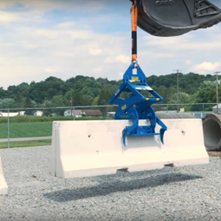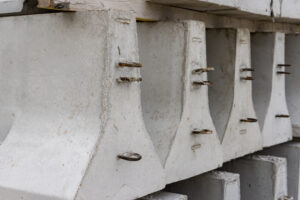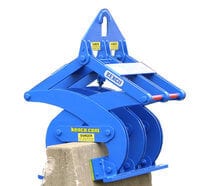The construction industry can generate staggering amounts of waste, but that doesn’t mean you can’t find easy and accessible ways to make your project eco-friendly. According to the Environmental Protection Agency, the construction and demolition industry generated 600 million tons of debris in 2018. That’s more than double the amount of municipal solid waste (a.k.a. household trash) in that same year. Luckily, a few simple strategies can reduce the waste and environmental impact of your next barrier project.
Responsible Materials
Innovative products can turn industrial waste into durable, aesthetically pleasing construction materials. At 48 Barriers, we carry Pretred barriers, a line of rubber barriers constructed of recycled tires.
Whether you’re trying to satisfy LEED certification requirements or merely trying to manage your project’s budget and environmental impact responsibly, Pretred barriers have a lower carbon footprint than their concrete counterparts. Consisting of 95% recycled materials, these barriers can be recycled again into new barriers at the end of their lifecycle.
Much like concrete barriers, Pretred barriers are strong and long-lasting, serving well in construction, traffic, event management, and industrial applications.

Consider Secondhand
Used or pre-owned barriers can present a significant cost-saving in your project. They can also drastically reduce your environmental impact. According to a Princeton University study, the concrete industry generates 4 billion tons of carbon dioxide annually (about 8% of all global emissions). Each pound of concrete releases 0.92 pounds of carbon dioxide, an almost one-to-one ratio. By foregoing the creation of new concrete barriers, you can minimize your environmental impact by simply using barriers that are already on the market.
A common hesitation about buying used or pre-owned barriers is that they will look worn out or will no longer be structurally sound. Fortunately, companies like 48 Barriers rely on a grading scale that can help buyers easily determine the quality of used barriers. For example, barriers labeled high-grade are in “like new” condition. These barriers have little to no wear and maintain all of their structural integrity. The best part is they also come at a significantly lower cost.
At 48 Barriers, our scale ranges from high-grade, “like new” condition; mid-grade, with minor cosmetic cracks; or low-grade, which are structurally sound but have significant cosmetic wear.
Don’t Need It? Don’t Keep It!
Much like buying secondhand, renting barriers is another great eco-friendly option. Because you are using existing materials, you’re not generating new carbon emissions. The added bonus of renting barriers is that, when you’re finished with them, you can return them. This saves the hassle of securing a storage site, transporting your barriers, and maintaining their condition.
Rented barriers are even more cost-effective than secondhand barriers because you only pay for them through the duration of your project, making them a great option for temporary or short-term applications.

Care & Keeping
If you buy or already own concrete barriers, taking care of them can keep you from having new ones made. Safe storage and transportation techniques can ensure that your barriers have a long lifespan. Storing barriers in a dry, secure location like a warehouse or a storage yard can keep them from being damaged.
For transporting barriers, barrier lifts guarantee safe transport and minimize chipping, cracking, or dropping of your barriers. By taking care of what you have, you can ensure a long lifespan for your barriers. In the long run, this can save you money and help your project be even more eco-friendly.

Double Duty
Finally, even buying new barriers can be an eco-conscious move if you think about creative uses for your barriers. Thanks to an ever-expanding line of decorative barriers, many security and traffic barriers can serve double-duty. These rebar-reinforced concrete structures can fulfill the safety duties of a regular concrete barrier and the beautification work of planters, art installations, or even patio surrounds. These two-in-one products save you the time, money, and the environmental footprint of buying multiple products to serve the same function.
Whether environmental consciousness is your top concern or simply an added bonus, concrete, Pretred, and decorative barriers from 48 Barriers can be an eco-friendly choice for your next project. When you’re ready to get started, give us a call.





